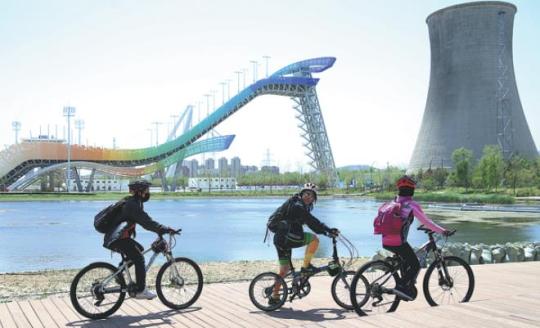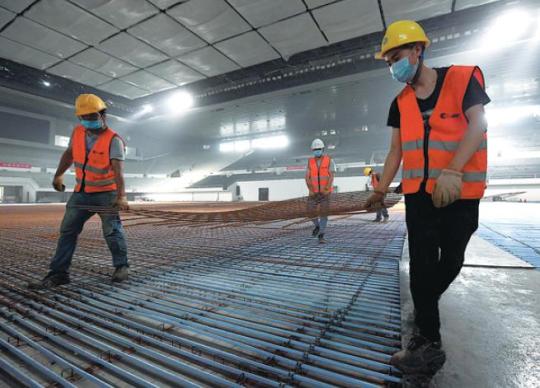
Construction work continues at the National Speed Skating Oval in Beijing, which is due to be completed by October. (Photo by Wei Xiaohao / China Daily)
Beijing plans sustainable sporting spectacular
Beijing is well on track to fulfilling its promise to host a green and sustainable Winter Olympics in 2022, with the work done to date involving eco-friendly solutions and carefully drawn up plans for use of facilities after the Games.
With the COVID-19 outbreak in China now under control, preparations for the sporting spectacular are in full swing again in all three hosting areas-downtown Beijing, the city's northwestern district of Yanqing and the co-host city, Zhangjiakou, Hebei province.
All venues for the Games, comprising newly built or renovated facilities, will be ready by the end of this year in time for the 2020-21 winter season, when a series of official trial events will be staged in the hosting areas, according to the Beijing Organizing Committee for the 2022 Olympic and Paralympic Winter Games.
This impressive progress is perhaps best illustrated at Xiaohaituo Mountain in Yanqing, where two new venues-the National Alpine Skiing Center and the National Sliding Center-have taken shape over the past three years. Ecological protection and energy efficiency have been the top priorities.
All the courses being used for competition at the skiing center, China's first alpine resort with a drop of more than 800 meters, were completed by the end of last year.
In 2022, the venue will host 11 Olympic disciplines, including downhill and giant slalom.
The venue's design features an efficient water recycling system, which will collect rainwater and store melted snow at two high-altitude reservoirs. The water will then be pumped up to snow-making machines along the slopes, where man-made snow is needed for course preparation during dry winters, according to the property's owner and constructor, Beijing Enterprises Group, or BG.
The sliding center for bobsled, luge and skeleton events features a wooden roof covering its entire length of 1.9 kilometers, providing an effective sunshade to reduce energy consumption and keep the track frozen.
Li Changzhou, a deputy general construction manager for BG, said last week at the construction site, "Technically, it was almost mission impossible to build these projects, which we've never had before, in just three years.
"Our goal is to meet the requirements for hosting such sports to the highest standard while ensuring that the construction and operations are as energy-efficient as possible."
The sliding center, the most technically challenging venue to build, will be completed this fall before a track uation mission by the International Bobsleigh and Skeleton Federation and the International Luge Federation to validate the course's safety.
After the Games, both venues will host international races and act as training bases for national teams.
Despite the massive earthworks and engineering work involved, the need to protect vegetation was taken into account at Xiaohaituo Mountain.
Liang Dedong, a BG executive overseeing environmental protection and sustainable development, said that based on a pre-construction uation, more than 24,000 trees were transplanted from the mountain ridges, where ski slopes and sled courses are being built, to a nearby 53-hectare forest park.
"Protecting the fragile ecological environment and ensuring minimal impact on the forest and wildlife is the top priority for our construction work. We are proud to see that over 90 percent of the transplanted trees have survived and flourished in their new home at the park," he said.
Reuse of venues

Cyclists pass the Shougang Big Air ramp in Beijing, which will be used for freestyle skiing and snowboarding events in 2022. ZOU HONG/CHINA DAILY
Using the existing facilities built for the 2008 Summer Olympics in Beijing, downtown venues have been adapted to host competitive events and ceremonies for the 2022 Games, paving the way for a sustainable future for permanent Olympic projects.
Thirteen venues will be used for competitive and non-competitive events in the downtown area, where all the ice sports will be staged, with 11 sites used in 2008 being renovated.
For example, the National Aquatics Center, also known as the Water Cube, which hosted the Olympic swimming and diving events in 2008, has been transformed into the Ice Cube for the curling events in 2022.
The work featured a yearlong renovation project, which involved filling the main pool with removable steel structures and making ice sheets, which will be placed over the pool.
Yang Qiyong, the venue's general manager, said that after staging a national junior curling tournament in December as a trial event, the venue can now be switched between hosting summer and winter events, marking a significant diversification in its business operations.
"Thanks to the opportunity to host Winter Games events, our business has benefited from the introduction of a new sport, and we have added a wider range of attractions to our portfolio," Yang said.
At the National Indoor Stadium, which lies to the north of the National Aquatics Center and was used to host gymnastics in 2008, the temperature-control system and lighting are being upgraded in preparation to stage the hockey events in 2022.
Work on transforming the National Stadium, also known as the Bird's Nest, and the National Convention Center, for ceremonies and broadcasting respectively, will be completed next year, according to the Beijing Major Projects Construction Headquarters Office.
Liu Xinping, director of sustainability with the Beijing 2022 organizing committee's general planning department, said, "By repeatedly using ready-made facilities, this innovation works well by cutting unnecessary spending while diversifying venue functions for improved post-Olympic operations."
Reusing venues reflects China's efforts to meet the International Olympic Committee's reform agenda, which is aimed at making future Games cost-effective, intelligent and green, Liu added.
New technology

Workers lay wiring at the Capital Gymnasium in Beijing. WEI XIAOHAO/CHINA DAILY
Featuring clean energy and the latest refrigeration technology, new areas of eco-friendly development are being explored at some venues built for the 2022 Winter Olympics, including the National Speed Skating Oval.
Built on the archery field used for the 2008 Games in northern Beijing, the Oval will be the first venue in the world of such size to use carbon dioxide, instead of the environmentally harmful substance Freon, as a refrigerant to make and maintain a 12,000-square-meter ice surface for speed skating.
With 22 strands of light illuminating its exterior, the Oval, known as the Ice Ribbon, is due to be completed by October and is expected to provide the best-ever conditions for the world's top long-track speed skaters.
Ma Jin, an engineer in charge of ice-making at the venue, said, "We are confident of making the fastest-ever ice circuit for speed skating because we are using the new refrigeration system.
"The carbon dioxide-based cooling system is capable of lowering the ground temperature instantly and maintaining the temperature at any point on the surface to make lubrication as consistent as possible."
After the Games, it is planned to turn the venue into a sports and entertainment center for the public. This will involve splitting the giant ice surface into a number of rinks for figure skating, short-track speed skating and hockey, according to the venue's operators.
Song Jiafeng, deputy general manager at the Oval, said: "The design gives the venue the flexibility to cater to the varying needs of different groups of ice sports fans. It will offer local residents an affordable choice to enjoy entertainment on ice after 2022."
For the first time at a Winter Olympics, all the venues in 2022 will be fully powered by green energy thanks to a new power grid operating across northern highland regions of the country. Electricity will be generated from renewable sources such as solar and wind energy.
Mass participation
As China prepares to host the Games, there has been a dramatic increase in winter sports participation.
Once a poor county nestling in mountains and little-known to the rest of the country, Chongli district in Zhangjiakou, where most of the snow sports will be held in 2022, is already benefiting from the Games.
Linked to Beijing by a high-speed rail line that began operating in December, Chongli has become one of the country's hottest skiing destinations. The line has reduced traveling time between the capital and mountain resorts from more than three hours by car to about 50 minutes.
The Olympic venues for cross-country skiing, biathlon and ski jumping can be reached by shuttle bus from Taizicheng station, the final stop on the line in Chongli. An increasing number of arrivals were using the station until the COVID-19 outbreak forced all seven major ski resorts in Chongli to close in late January.
However, before the onset of the pandemic, the rising number of tourists to Chongli in recent years bore testimony to the influence of the 2022 Games.
During the 2018-19 winter season, a record 1 million-plus skiers and snowboarders visited Chongli, more than double the 480,000 in the 2015-16 season, according to the district tourism bureau.
By 2022, as part of a national plan to further promote winter sports as a lifestyle choice, China aims to build 650 skating rinks and 800 ski resorts, up from 334 and 770 respectively by the end of last year. This work will lay the foundation for winter sports and recreational activities for 300 million people in the buildup to the Games.
Bullish outlook
Although there was an unprecedented fall in winter revenue due to the pandemic, ski industry insiders remain bullish about the sector's long-term future. Resort owners predict a rebound in the 2020-21 winter season in the buildup to the Olympics.
Luo Li, founder and chairman of Wanlong Paradise Resort in Chongli, said during an online forum in April, "As long as we can meet the challenge, which I believe we can, we will see a recovery from next winter, with a rebound in consumption very likely.
"A public health crisis such as this pandemic will inspire people to embrace more-active lifestyles through sports participation, which I believe will be a boon for the outdoor leisure industry as a whole."
China's determination to promote winter sports ahead of the 2022 Games, despite the challenges posed by the pandemic, has impressed the International Olympic Committee.
Juan Antonio Samaranch, an IOC vice-president and chair of the committee's coordination commission for the 2022 Games, said after a meeting with the organizers in June: "China has faced an incredibly difficult period over the past few months. Our thoughts are with all those who have been impacted.
"Not only have we seen important progress with the venues, but the efforts to engage millions of people in winter sports are heartening."
